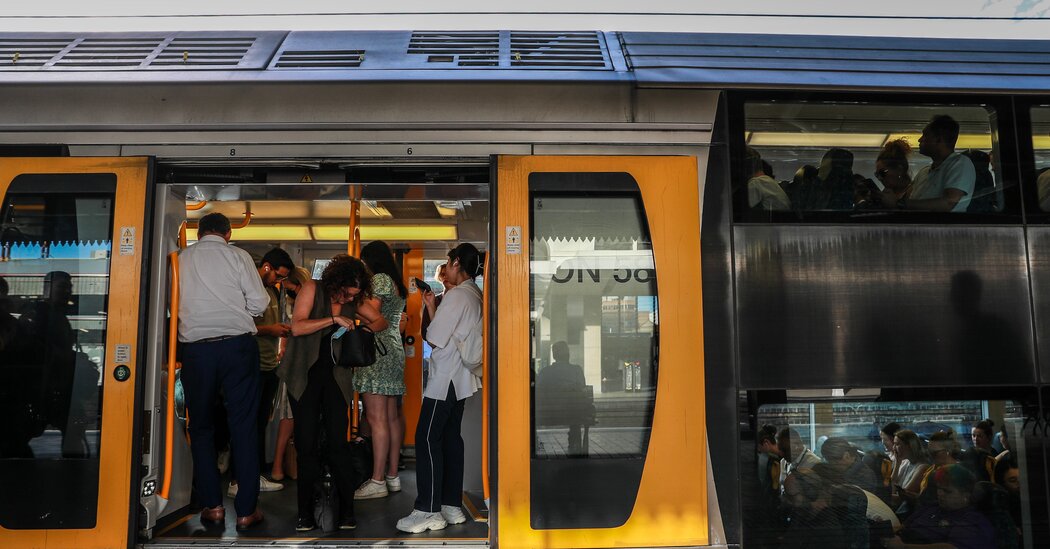The Australia Letter is a weekly newsletter from our Australia bureau. Sign up to get it by email. This week’s issue is written by Natasha Frost, a reporter in Melbourne.
Last year, more than 8.2 million seats were allocated to the flight route between Melbourne and Sydney, placing it among the world’s most heavily trafficked. (Before Covid, it was even busier.) That might seem surprising, giving Australia’s comparatively small population. But the reason lies in the alternatives, or lack thereof.
Suppose you were traveling between Tokyo and Hiroshima, also a distance of about 840 kilometers, or roughly 520 miles. You could fly, if you wanted. But you’d probably choose to take the high-speed train, which takes less than four hours and avoids the fuss of checking in, elbowing your way through airport security and traveling to and from the airport.
Going between Melbourne and Sydney — or even Melbourne and Canberra — you simply don’t have that option. And while you could take a painfully slow overnight train or tackle a drive of a similar length, it’s understandable that most people simply book a seat on a 90-minute flight.
For almost 40 years, politicians have been talking about a rail alternative. Yet despite decades of proposals, working groups and budgets drawn and redrawn, the main way to get around Australia’s Eastern Seaboard is still on a plane.
Rail enthusiasts in Australia might remember the “Very Fast Train” venture of the 1980s, or the Speedrail proposal of the 1990s, or even efforts in the mid-2010s to explore both high- and medium-speed rail between Australia’s eastern capital cities. All of these came to nothing.
All told, high-speed rail has been explored by governments led by John Howard, Kevin Rudd and Malcolm Turnbull, among others, to a total cost, according to one estimate, of around 150 million Australian dollars, or $100 million.
In each case, proposals have been stymied by a combination of shifting political winds and concerns about the cost.
Australia’s lack of a cohesive national rail system dates back to the country’s Federation, at the turn of the 20th century, said Philip Laird, a professor at the University of Wollongong and an expert on Australian rail.
“Our founding fathers agreed that the post, the telegraph, the defense and the currency would all go to the new Commonwealth, now called the Australian or federal government,” he said. “The new states, they said, would keep the railways.”
“That’s why we’ve got this stupid situation where, if you fly from Melbourne to Adelaide, it’s regulated by the federal regulator, but if you fly from Melbourne to, let’s say, Mildura in Victoria, it’s regulated by the state government,” he added. “We’re paying a high price for this decision taken in Adelaide in the 1890s.”
Fast-forward nearly 140 years and not only does Australia not have working, high- or medium-speed rail links between its major cities, it uses three separate rail gauges. (The United States, by contrast, has been using the same rail gauge nationwide since 1886.)
Yet change may be in the air.
In June, the Australian government announced the establishment of a High Speed Rail Authority to oversee the development of a rail network along Australia’s east coast, starting with a proposed link between Sydney and Newcastle.
For the first time, an Australian government has put 500 million Australian dollars on the table toward high-speed rail — a substantial sum, even if it is only the smallest fraction of the total potential costs.
It comes as Australia hopes to reach “net zero” on its carbon emissions by 2050, a goal that it will struggle to meet if domestic flight and freight by road continue to be the most important ways of ferrying people and goods between Melbourne, Sydney and Adelaide. A functional rail corridor could be one critical step toward meeting it.
“Legislation has been passed to establish this authority, and there’s a very clear mandate to do something,” said Dr. Laird. “So this time around, it is different.”
Whether, together, these steps are “enough to actually secure the land and the corridors, and get through the environmental impact assessment hurdles, and start construction remains to be seen,” he added. “I’d love to see it.”
Here are the week’s stories.
Are you enjoying our Australia bureau dispatches?
Tell us what you think at [email protected].
Like this email?
Forward it to your friends (they could use a little fresh perspective, right?) and let them know they can sign up here.

